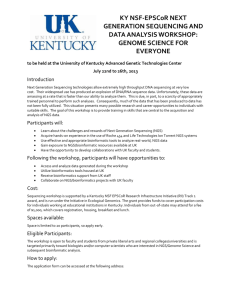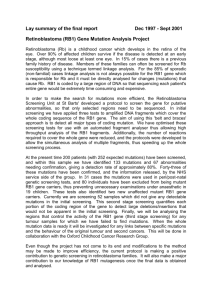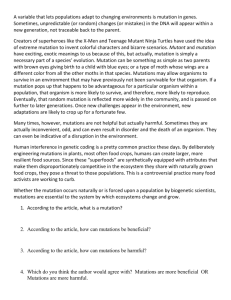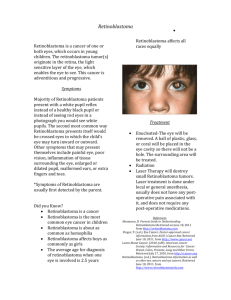(this is the final Report). - Childhood Eye Cancer Trust
advertisement
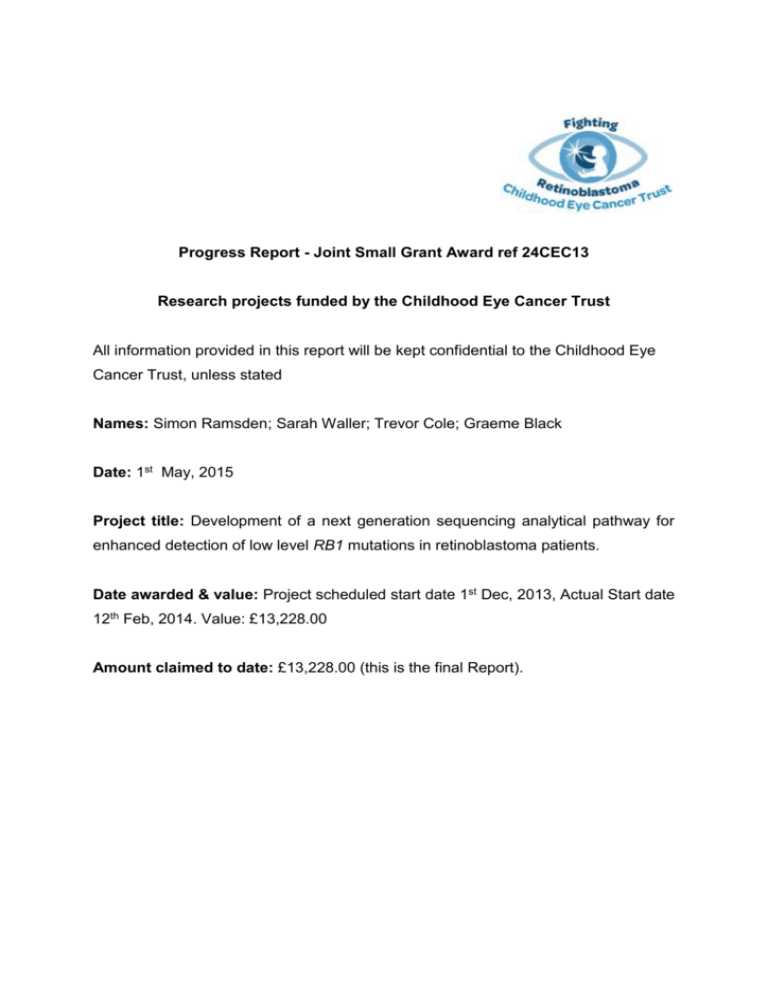
Progress Report - Joint Small Grant Award ref 24CEC13 Research projects funded by the Childhood Eye Cancer Trust All information provided in this report will be kept confidential to the Childhood Eye Cancer Trust, unless stated Names: Simon Ramsden; Sarah Waller; Trevor Cole; Graeme Black Date: 1st May, 2015 Project title: Development of a next generation sequencing analytical pathway for enhanced detection of low level RB1 mutations in retinoblastoma patients. Date awarded & value: Project scheduled start date 1st Dec, 2013, Actual Start date 12th Feb, 2014. Value: £13,228.00 Amount claimed to date: £13,228.00 (this is the final Report). Aims / Objectives of project: Retinoblastoma is a rare type of eye cancer that affects children under the age of five and is caused by mutations in the RB1 gene. It is usually detected and treated early in the UK and molecular genetic analysis is an essential part of the patient follow up, informing disease progression (predicting bilateral disease) and enabling accurate disease prediction for family members. Currently both unilateral and bilateral patients undergo molecular genetic analysis to determine whether a germ-line mutation can be identified in the blood and testing strategies are designed primarily to detect mutations present at significant levels. In some children, however, the mutation occurs in the early stages of fetal development in which case the patient will be a mosaic and the mutation may be difficult to detect in the blood. In this situation there is a risk that a disease causing mutation will be overlooked. We aim to deliver a sequencing protocol designed based upon so called “Next Generation Sequencing” to maximise the detection of RB1 mutations and improve the time taken to achieve a molecular genetic diagnosis of Retinoblastoma. The protocol will be developed to conform with diagnostic standards (ISO/IEC 17025:2005) and will replace the existing strategy based upon Sanger sequencing technology. Lay summary of project (200-500 words to be completed at the start of project NOT CONFIDENTAL - to be displayed on CHECT website): Retinoblastoma (RB) is a rare type of eye cancer that usually affects children up to the age of five. Although this can be very distressing over 9 out of 10 children with RB are cured in the UK. RB is often inherited within families and when a patient develops the disease family members will be concerned as to the likelihood of recurrence in the family. RB is caused by mutations in the RB1 gene and an essential part of patient and family management is the molecular genetic analysis of the RB1 gene in the blood of an affected child in order to find the causative mutation. Not all patients will have a mutation in the blood (unilateral patients are less likely to have one than bilateral) and some mutations are very difficult to find as they are only present in a minority of cells in the body. However the identification of a mutation is important as it facilitates presymptomatic screening for family members, and excludes unnecessary surveillance in relatives at population risk. This project takes advantage of new and exciting DNA sequencing technologies which can identify mutations at much lower levels in the blood than was previously possible. By increasing screening sensitivity we hope to remove the need for costly and distressing surveillance for more children born to families living with this disease. ASSAY DESIGN AND VALIDATION Assay design and laboratory pipeline: The sequencing assay design is based on gene enrichment by long range PCR, equimolar pooling, fragmentation and tagging using Nextera XT followed by next generation sequencing on a MiSeq DNA sequencer. Primers were designed to ensure maximum coverage (including the promoter and relevant intronic regions) – see Figures 1 and 2. Figure 1: Assay design. 27 exons covered by 11 long range PCR fragments: Region of interest defined as exons +/- 15bp intronic sequence plus deeper intronic regions: c.861+828+/-50bp, c.1215+63+/30bp, c.2490-1398+/-50bp, c.1814+1291+/-50bp. Figure 2: Laboratory workflow. Bioinformatic pipeline: We align the sequencing reads using bwa/stampy to the human genome build GRCh37. Once the aligned files are generated we use a consensus model to critically evaluate variants called by Varscan and Dreep down to 4% ratio with a negligible strand bias (based on the assumption that with single molecule sequencing the same random sequencing errors are unlikely to arise simultaneously on both strands of an amplified fragment). This has been validated by challenging with both known mosaics and admixture samples. In order to achieve this level of sensitivity we have established a minimum coverage of 100% of bases covered at 100x depth and an average coverage of 1000x per exon. Initial MiSeq runs showed reduced coverage of exon 1 due to high GC content. Primers were redesigned in order to break the assay into smaller fragments. In this way we have been able specifically “over-represent” the region of low coverage when pooling to Average Coverage satisfy the minimum quality thresholds (see figure 3). Figure 3: Example data for four patients showing average coverage achieved across the RB1 gene in order to satisfy the minimum quality thresholds (>1000x). Sanger Confirmations: All variants identified in a screening test need to be confirmed on a second dilution of the original DNA sample. We currently use Sanger sequencing for this. RESULTS The assay has been assessed against the required standards for use in the diagnostics laboratory. Part of this assessment has been a dual analysis in parallel with the existing Sanger analysis. This comparison yielded no discrepancies (accuracy) between the two methods (although differences in sensitivity – see later). The first reports using this technology were issued in August 2014 and we are now using the new pipeline without parallel analysis. As well as NGS to look for point mutations we use MLPA to look for larger scale insertions and/or deletions. RB1 NGS analysis has been used to analyse 52 patients. See table 1. Phenotype Bilateral Retinoblastoma Unilateral Retinoblastoma Retinoblastoma (not specified) Total Number 13 34 5 52 Table 1: Screening carried out since the introduction of NGS Bilateral Retinoblastoma: With bilateral retinoblastoma we would expect to find a mutation in the blood in the majority of cases. 13 patients had bilateral RB and testing was performed directly on the patient’s blood. Mutations were detected in 11/12 (91%) (one sample failed analysis). Unilateral Retinoblastoma: With unilateral retinoblastoma we would only expect to find a mutation in the blood in approximately 15% of cases. In this clinical setting there are two ways to approach testing: i) If the affected eye has been enucleated then we will first try to characterise the molecular cause of the disease in DNA extracted from the tumour in the enucleated eye as this will maximise the chances of identifying the mutations. On identification of the mutations in the retinoblastoma we will target testing in the blood specifically for that mutation. 14 of the unilateral cases were initially tested on a tumour sample with reflex testing on a blood sample. Mutations were detected in 13 of 14 (92%) of tumours from unilateral patients. ii) In the remaining 20 unilateral cases no enucleated material was available for investigations and consequently we tested the blood directly. When the primary screen was completed on the blood sample we identified a mutation in 2/20 (10%). Testing Turnaround Times: One of the objectives of this work has been to demonstrate a reduced time taken to achieve a molecular diagnosis. In fact when we look at turnaround times (the time taken to issue a report from date of sample receipt see figure 4) we note that over the time period of this validation and implementation the turnaround times have not decreased (September 2014 shows a longer time to diagnosis due to the additional burden of undertaking the dual running in order to Number of working days validate the current protocol). National Turnaround Target Figure 4: Average turnaround times for RB1 screening. The NGS testing pipeline is considerably less time consuming to perform, both in terms of laboratory analysis as well as scientific interpretation and it is interesting to consider why this has not led to a decreased time to reach a diagnosis. Without a doubt this reflects the complex nature of the testing pipeline which must take into consideration a number of elements that are independent of the NGS screening process namely: Batching of samples. MLPA analysis Sanger confirmations of screening results We will continue to work on these elements of the process in order to address this important aspect of quality. It is important to note that current time periods remain well within the 40 day National target. Reflex testing: NGS identified mutations in 10/13 of the unilateral tumours where we were able to provide a molecular confirmation of the retinoblastoma (the remainder had deletions identified with MLPA as the first “hit”). In order to assess the test sensitivity we looked for the presence of these mutations in the patients’ blood sample using both Sanger and NGS in parallel. Sanger sequencing was able to identify the first hit in the blood in 4 of these leaving 6 cases apparently “negative” ie without a first “hit” confirmed in the blood. NGS was used to screen these apparently negative cases and the first “hit” was confirmed in a further 2 of these (see table 2). Lab No First “Hit” Second “Hit” Result in Blood Using Sanger 14020459 c.1251_1252delAA c.1399C>T p.(Arg467Ter) LOH None Result in Blood using NGS None Ex1-27del None None None None None None c.1363C>T p.(Arg455Ter) Mosaic (3%) c.2520+1G>C Mosaic (6.6%) 14010241 c.1330C>T p.(Gln444Ter) 14017696 c.1961_1966delins93 LOH 3 copies of c.1363C>T 15000236 RB1 exon 1 & p.(Arg455Ter) LOH c.2053C>T 14020942 c.2520+1G>C p.(Gln685Ter) c.2359C>T 14019591 c.380+1G>A p.(Arg787Ter) 14014221 c.145delT 14019034 c.1333C>T p.(Arg445Ter) Ex1-27del 14010235 c.1399C>T p.(Arg467Ter) LOH 15001501 c.273T>A p.(Tyr91Ter) LOH None None c.380+1G>A Het c.1333C>T p.(Arg445Ter) Mosaic c.1399C>T p.(Arg467Ter) Het c.273T>A p.(Tyr91Ter) Het Not analysed Not analysed Not analysed Not analysed Table 2: Comparison between Sanger sequencing and NGS in the detection of mosaic RB1 mutations. SUMMARY We have used the funding from the Childhood Eye Cancer Trust and Fight for Sight to develop a next generation sequencing assay to replace conventional Sanger sequencing. By the use of control samples we have established minimum acceptable quality thresholds required and have further demonstrated that this technique achieves equivalent pick up rates to Sanger sequencing in both unilateral and bilateral patients. We have increased the sensitivity of mutation detection in cases of mosaicism in those families where we have been able to confirm a mutation in the blood. This will facilitate: Earlier identification of children (relatives of an affected child) at low risk of developing retinoblastoma. Removal from costly and invasive clinical surveillance for children whose risk is reduced. Better prognosis of disease progression. Appendices 1 and 2 illustrate these points by the use of two case reports. Details of any publications / presentations of results at meetings etc. Presentation: The Molecular Investigation of Retinoblastoma - Simon Ramsden. 22nd Sept 2014 at the British Society for Genetic Medicine annual meeting, ACC, Liverpool. APPENDIX 1 Case study 1: A patient (local ref: 15000236) was referred with unilateral retinoblastoma. In this case three potential mutational mechanisms were identified in the tumour: A) c.1363C>T p.(Arg455Ter) present at a high level (95%). B) Loss of heterozygocity for markers within and flanking the RB1 locus C) An RB1 intragenic duplication (three copies of exon 1) (see figure 5). Figure 5: Molecular tumour results for patient 15000236. A) c.1363C>T p.(Arg455Ter) at 95% (reflecting a level of stromal contamination). B) Loss of heterozygocity with tumour profile in blue, blood profile in red. C) MLPA showing an exon 1 gain. In this case we can categorically state that the first “hit” is c.1363C>T p.(Arg455Ter). The loss of heterozygocity accounts for the second hit and it is not clear as to whether the exon 1 gain is an inactivating mutation (as the location has not been established). Sanger sequencing in this case had not able to identify c.1363C>T p.(Arg455Ter) in the blood leaving the possibility of recurrence unresolved in this family (see figure 6A). NGS analysis was therefore used to confirm the presence of the first “hit” in the blood and consequently clearly delineate recurrence risk to the future offspring of the proband (see figure 6B). Figure 6: Molecular blood results for patient 15000236. A) c.1363C>T p.(Arg455Ter) Not visible using Sanger sequencing. B) c.1363C>T p.(Arg455Ter) visible at 3% using NGS. APPENDIX 2 Case study 2: A patient (local ref: 14020942) was referred with unilateral retinoblastoma. Two point mutations were identified in the tumour (both at approximately 50%): i) c.2520+1G>C ii) c.2053C>T p.(Gln685Ter) Neither of the mutations were identified in the blood using Sanger sequencing and as a result we were not able to establish the first “hit”. This leaves the proband at residual but unspecified risk of passing a mutation on to the offspring, however this uncertainty is compounded by not knowing which of the two mutations to look for in “at-risk” family members. NGS was able to confirm the presence of c.2520+1G>C in the blood at 6.6% (see figure 6), c.2053C>T was not present in blood using NGS. Figure 6: Molecular blood results for patient 15000236. A) c.2520+1G>C in the tumour at 47%. B) c.2520+1G>C in the blood at 6.6% Testing for c.2520+1G>C is now available for “at-risk” relatives in the hope that they can be excluded from unnecessary surveillance.
